

20-Minute Functional Core Training (Strong 20, Day 9)
Strengthen the core and increase balance and stability with this quick and effective workout: Functional Core Training. These core training exercises build strength for the movements you do in daily life, such as pivots, twists, bends, rotations and presses. Build core strength and core stability by training in multiple planes of motion.
This is DAY NINE of our Strong 20 Program.
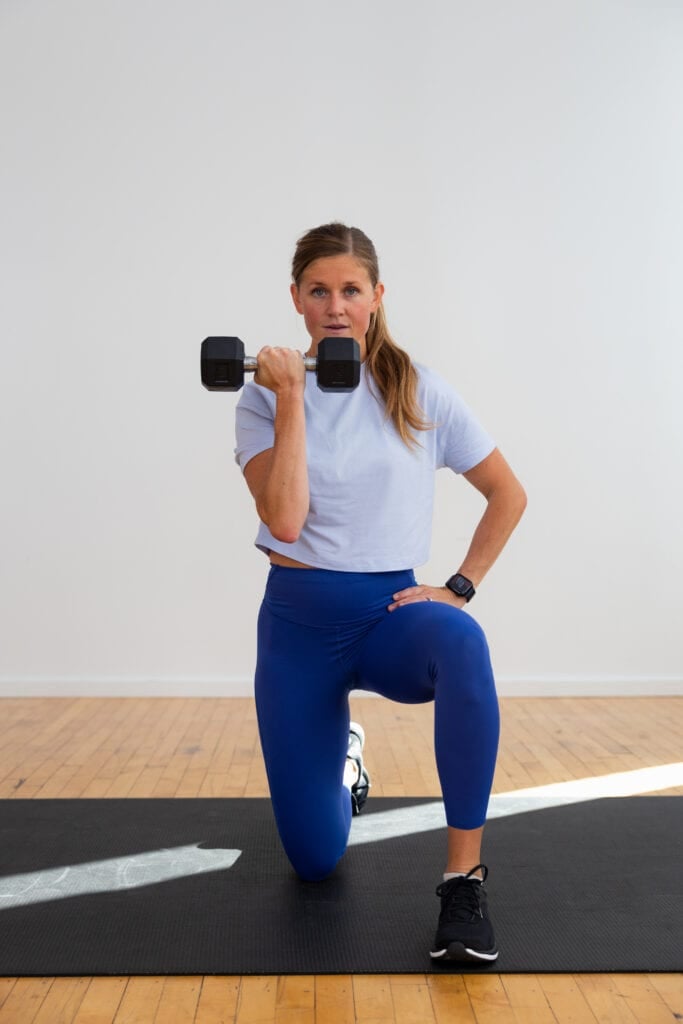
LET’S GET STARTED
Download Your FREE Strong 20 Workout Plan
Strength, stability and definition: these functional core exercises are the best way to build all of the above.
The ninth day of our Functional Strength Training Program focuses on building core strength and stability so you can lift heavier and move throughout your daily life with ease.
This core workout prioritizes movement patterns you use in everyday life: pivots, twists, uneven weight carry and weight transfers, and balance work.
Core stability and strength are vitally important, whether your goal is to increase your maximum squat weight or prevent injury from lifting a carseat or carrying a baby on your hip.
Today’s workout trains the core from all angles and from different planes of motion, resulting in increased core strength, better coordination and stability and reduced risk of injury.
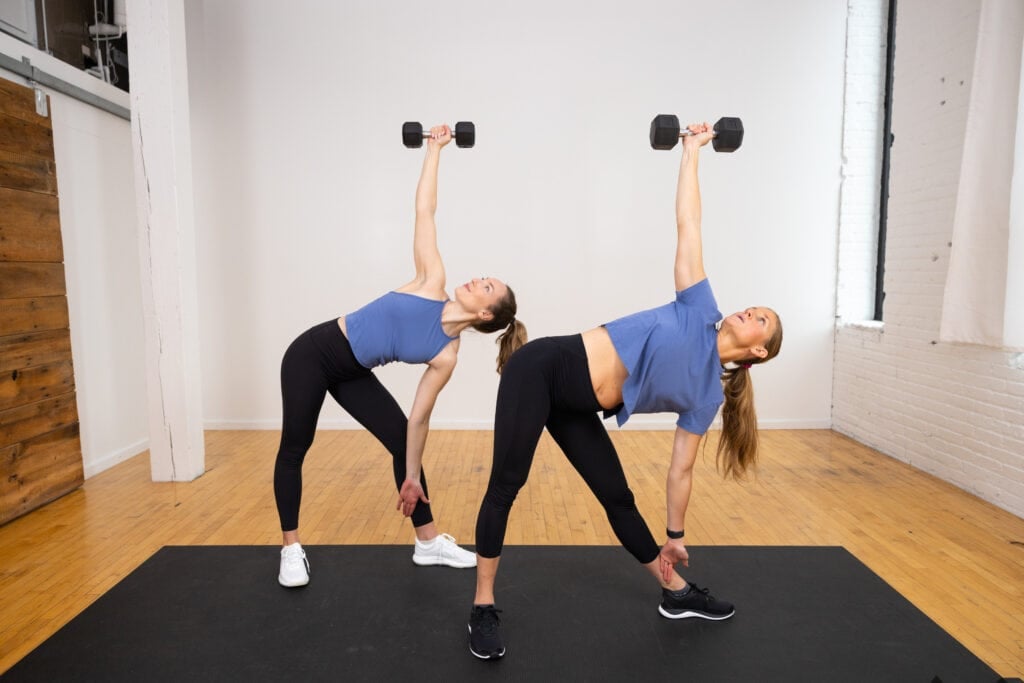
Functional Core Training FAQs
Functional core exercises build strength and stability in a way that is relevant to your daily life or training. Most functional core exercises focus on activating the core muscles, increasing stability in the surrounding muscles, and progressively strength training the core muscles.
Functional core exercises are effective for both aesthetics and performance. Strength training your core increases definition and builds the strength and stability you need to move through your daily activities with ease.
Most people think of the rectus abdominis, or “six-pack” muscles when they think of the core, but it’s so much more than that. The core also includes the obliques (sides of your body), erector spinae, pelvic floor, transverse abdominis (or deep, corset-like ab muscles), diaphragm and the glutes.

20-Minute Functional Core Training (Strong 20, Day 9)
Strengthen the core and improve daily movement patterns with this Core Training Workout With Weights.
This functional strength workout combines the best core exercises to target the muscles that support and stabilize your body through all your daily movements.
I suggest doing this functional core training workout once a week as part of a well-rounded workout routine.
Workout Equipment:
Medium set of dumbbells.
I recommend 8-30 lbs depending on your fitness level. We’re using 15-20 lb dumbbells in this workout. The last 2-3 reps of each exercise should be challenging to complete with good form.
Shop My Extra-Large Yoga Mat
DISCOUNT CODE: NourishMoveLove
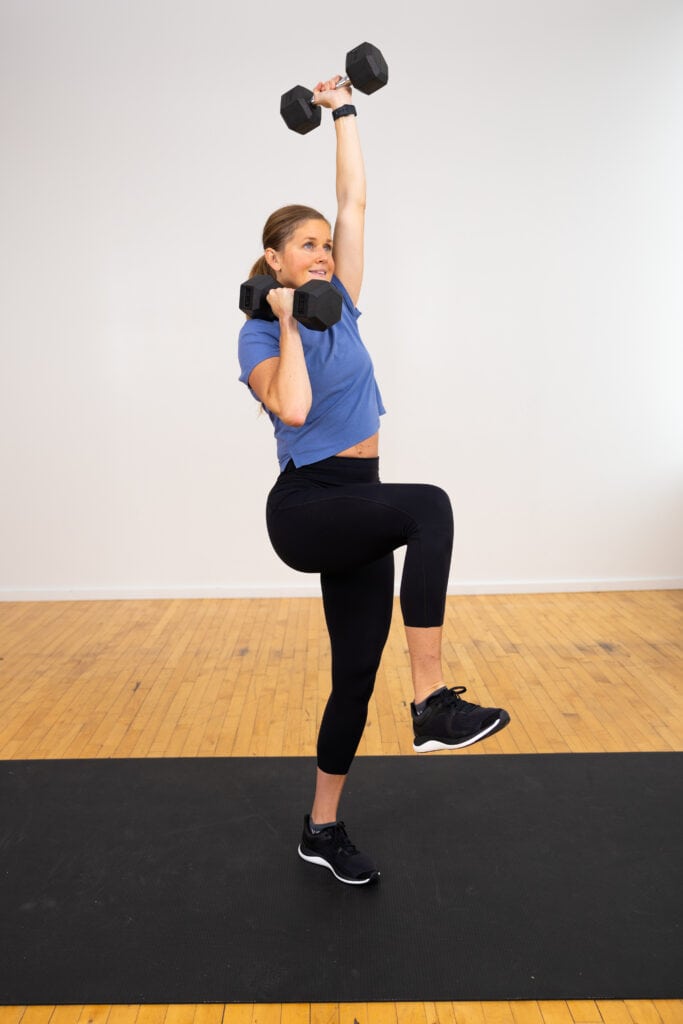
Workout Instructions:
Follow along with the guided Functional Core Training Workout on YouTube, led by certified personal trainer and fitness instructor, Lindsey Bomgren.
Your Workout Looks Like This:
- 12 Functional Core Exercises
- Timed Intervals (30 seconds work, 10 seconds rest. Complete as many reps as you can in the timed interval)
- Perform Each Exercise x2 (back-to-back, then move on to the next exercise)
Workout Outline
- One Arm Front Rack and One Arm Overhead March
- Side Squat to Single Leg Thruster
- Deadlift to Single Leg Knee Drive and Overhead Press
- Single Leg Deadlift, Diagonal Lift and Knee Drive (Right)
- Plank Sprinter Step Ins
- Single Leg Deadlift, Diagonal Lift and Knee Drive (Left)
- Windmill
- Lateral Bear Crawl Walk
- Alternating Front Lunge, Twist and Halo
- Single Leg Balance Curl Press
- Dumbbell Chop, Squat, Press and Pass
- Hold the World and Reverse Crunch

Prefer to Watch On YouTube?
5 Best Functional Core Exercises
Front Rack and Overhead March
Targets: Lower abs, lower back, obliques, glutes, hip flexors, and shoulders.
This type of core work uses an uneven load (having one arm extended overhead) to engage all the muscles in your abs. It’s an anti-rotational exercise: meaning you focus on keeping your core engaged and still while other parts of your body are in motion.

How To Do A Front Rack and Overhead March
- Start in a standing position, feet hip-width apart, holding one dumbbell in each hand, palms facing in towards each other.
- Bring the dumbbell in your left hand to your left shoulder (a front-rack position) and press the dumbbell in your right arm straight overhead. Right wrist is stacked over right shoulder.
- Engage your core, then drive your right knee up in line with your right hip. Right knee bent at a 90-degree angle.
- Ground through your standing left leg for stability, then return your right foot back to the ground.
- Switch sides, driving your left knee up in line with your left hip. Return to starting position and repeat these alternating high knee lifts.
Side Squat to Single Leg Thruster
Targets: Legs, glutes, quads, hamstrings, hips, core muscles and shoulders.
Pressing a weight overhead engages all the stabilizing muscles in your around your shoulders and spine.
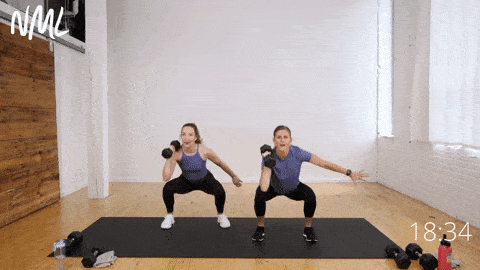
How To Do A Side Squat to Single Leg Thruster
- Start standing, feet hip shoulder width apart. Hold a dumbbell in your left hand at your left shoulder, palm facing in towards your body.
- Step your right foot out and lower your hips into a squat, bending both knees at a 90 degree angle and lowering until your thighs are parallel to the floor.
- Exhale as you press through both heels to stand tall. As you stand, drive both your left arm up, arm fully extended and dumbbell stacked over left shoulder. At the same time, drive your right knee up, balancing on your left foot. Right thigh is parallel to the ground.
- Hold this balance position for a second, then repeat, returning the dumbbell to your left shoulder, stepping your right foot out and lowering into a squat.
Modification: replace the knee drive with a toe tap, bringing your right leg in to a narrow stance before performing a shoulder press.
Windmill
Targets: Obliques, abs, upper back, outer glutes, inner thighs, hamstrings, upper body and shoulders.
The windmill is a full body exercise that strengthens the entire core as well as the shoulders. This move is especially effective for the obliques (sides of the torso).

How To Do A Windmill
- Start in a wide stance, holding a dumbbell in your left hand, directly above your shoulder.
- Rotate your right foot out 90 degrees so your right toes are pointing towards the top of your mat, then pivot your left foot slightly inwards (about a 45 degree angle). Think right heel aligns with left arch.
- Focus on creating and maintaining length through your waist as you hinge at the hips, sliding your right arm down your right leg. Keep your left hand directly above your left shoulder, maintaining a straight line with the dumbbell. Range of motion will look different for everyone
- Then, squeeze through your obliques to pull your torso back upright, returning to starting position.
Lateral Bear Crawl Walk
Targets: The deep transversus abdominis muscles, lower back, oblique muscles, hips, back, shoulders and core.
The bear crawl exercise is one of the best ab exercises for developing core strength. This exercise is also effective at building scapular and hip and core stability.

How To Do A Lateral Bear Crawl Walk
- Start in a table top position, quadruped on all fours, knees bent, shoulders stacked over wrists and hips stacked over knees.
- Tuck your toes under and lift your knees one inch off the mat, finding a bear crawl position with abs engaged. Belly button drawn in towards spine.
- “Walk” your right hand and right toes a step out to the right, following with the left hand and left toes. Keep your back flat and hips as stable as possible. Repeat, completing two “walks” to the right.
- Then reverse the movement, “walking” your body two steps to the left, this time leading with left hand and left leg.
Modification: perform alternating bird dogs instead of a bear crawl. From a quadruped position, extend first your right arm and left leg straight away from the body, then return to starting position. Then extend your left arm and right leg.
Alternating Front Lunge, Twist and Halo
Targets: Gluteus medius (the outer part of your butt used for side-to-side movements), quads, hamstrings, hip adductors and abductors, low back, shoulders and abdominal muscles.
This is also a great exercise to increase shoulder mobility.
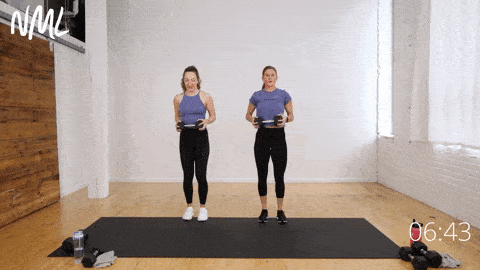
How To Do A Front Lunge, Twist and Halo
- Stand with your feet under hips, holding a dumbbell horizontally between both hands.
- Step your right leg forward into a front lunge, bending both knees to 90 degrees.
- Hold this low lunge position and perform a spinal rotation, rotating your shoulders towards the right, bringing the dumbbell towards the right hip. With control, bring the dumbbell back to center.
- Then, drive off your right foot to reverse the movement, exploding back up to center and returning to standing.
- From this standing position, perform a dumbbell “halo”, bracing your core as you pull the dumbbell in a smooth motion from your chest to left shoulder and then behind and around your head, before bringing it down to your chest again.
- Then step out with your left foot to perform another front lunge, this time on the left side.
- Then drive off your left foot to push back to standing, performing another “dumbbell halo” from a standing position.

Strong 20: FREE Functional Strength Training Workout Plan
A 2-week, functional training program designed to help you feel stronger and move better – in just 20 minutes a day.
If you liked this core workout with dumbbells, download the FREE, 2-Week Full Body Workout Plan.
Up Next:
See AllPin This Workout: Core Training (Strong 20 Day 9)
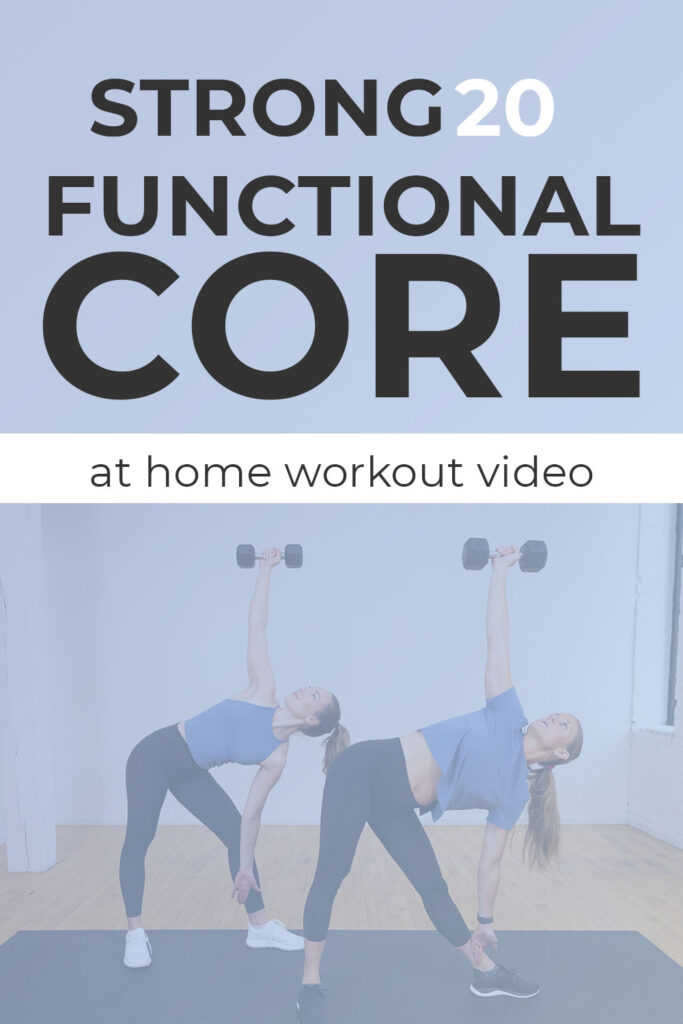
More Core Workouts:
- 5 Best Core Weighted Abs Exercises
- 35-Minute Dumbbell Ab Workout
- 35-Minute Cardio and Ab Workout With Weights
This post includes affiliate links. I do earn a commission for products purchased using these links (at no additional cost to you). Thank you for supporting Nourish Move Love, making the content you see on this blog possible.




















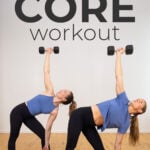

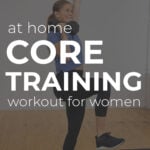
This particular workout (day 9) is hands-down the best workout I’ve done for my body. Not the “hardest” one I’ve done or the most fatiguing, but the one that benefits my body the most. Doing it for the third time today.
Thank you!
Jessica!! SO glad you loved Day 9 and the Strong 20 program! You are so awesome! Keep coming back for more! – NML team